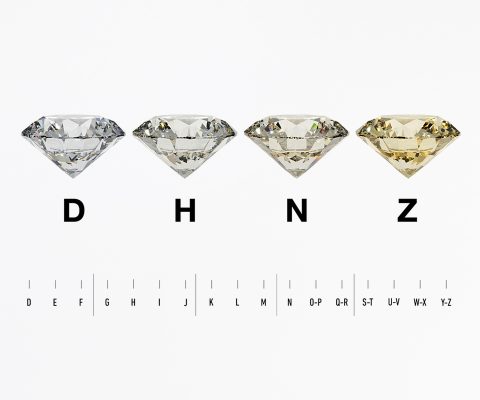Considering a diamond? Understanding color is crucial! Certified Gem Knowledge explains the GIA color scale, how it affects a diamond’s look and price, and how professionals assess this key quality factor. Let’s dive in.
The Official Diamond Color Grading Scale Explained
So, you’re exploring the 4 Cs of diamonds, and ‘Color’ has popped up. What does it really mean? Interestingly, for white diamonds, diamond color refers to the absence of color. Think of the purest water – that’s the ideal. That lack of color, or colorlessness level, allows light to sparkle through brilliantly.
Now, most diamonds naturally have tiny hints of yellow or brown. It’s normal! But how much color is present matters. That’s where the Gemological Institute of America, or GIA, comes in. Decades ago, diamond descriptions were all over the place. To fix this, the GIA developed the GIA Color Scale. Today, the GIA scale grades diamond colorlessness, and it’s the trusted standard worldwide. The GIA Color Scale standardizes diamond color grading, bringing clarity for everyone.
This scale uses letters. The GIA Color Scale has a range from D-Z. Why start at D? The GIA Scale’s start grade is D simply to avoid confusion with older, less reliable systems. It gives us a fresh, clear diamond tint scale.
Defining the D-to-Z Grades
Let’s break down this white diamond spectrum:

- Colorless (D-F): This is the top tier.
- D Color Diamond is the highest grade, showing absolutely no color. The D grade signifies complete colorlessness. It’s exceptionally rare and represents the peak absence of color.
- E and F grades are right behind D. They look virtually identical to the naked eye – pure and icy white. Only experts might spot minuscule differences. These colorless diamonds are most valuable.
- Near Colorless (G-J): This range is incredibly popular, and for good reason.
- A G Color Diamond, H, I, or J grade diamond has slight traces of color. But usually, you won’t notice it once the diamond is set in jewelry.
- They offer fantastic value. You get a diamond that looks colorless face-up without the premium price of the D-F range. Near colorless diamonds offer good value.
- Faint (K-M): Here, you might start to see a hint of warmth, a faint yellow or brown diamond hue.
- A K Color Diamond falls into this category. These diamonds can be beautiful, especially in yellow or rose gold settings. They offer excellent budget options.
- Very Light (N-R): The warmth becomes more noticeable in this range.
- Light (S-Z): Diamonds in this part of the scale have an obvious light yellow or brown tint. The Z grade signifies a clear light yellow/brown tint.
Understanding the grading diamond tone helps you know exactly what you’re looking at.
Understanding “Colorlessness Level” and Why the Scale Starts at D
The entire D-Z scale measures that colorlessness level. Remember, GIA is the acronym for Gemological Institute of America, the pioneers who brought us this consistent system starting intentionally at D. The goal was simple: universal understanding.
How Diamond Color Impacts Value and Visual Appeal
Why does color matter so much? Two big reasons: beauty and cost.
The absence of color is rare in nature. Therefore, colorless diamonds are rarest, and rarity drives price. The color grade correlates with diamond rarity. This direct link means rarity determines diamond value. A D-color diamond will cost significantly more than, say, a G-color diamond of the same size and clarity, precisely because it’s harder to find. Diamond color affects diamond value profoundly.
Visually, colorlessness impacts how a diamond interacts with light. A diamond with less color allows more light to pass through and reflect back as sparkle, or brilliance. So, the diamond appearance is influenced by colorlessness. While subtle differences between adjacent grades (like G and H) might be hard to spot, the collective impact on diamond price is noticeable. Even slight color differences can be subtle, but they matter financially. It’s a key factor for any investment diamond consideration, too.
The Professional Process for Assessing Diamond Color
You might wonder how experts pinpoint these subtle differences. It’s a precise process performed in a gemological laboratory.
Accuracy is paramount, so grading occurs under controlled light. Controlled lighting is required for accurate color grading. Gemologists don’t just eyeball it; they use a special tool: a master stone set. Gemologists use master stones for direct comparison. These master stones are used for color comparison, as each stone represents the exact threshold for a specific color grade. The master stones are calibrated to specific color grades.
To ensure consistency, the diamond is usually viewed loose (diamonds are graded loose) and placed table-down. This diamond color grading view makes it easier to see the true body color without distraction. This meticulous process ensures the grade you see on a report, like one provided via GIA diamond certification, is reliable. Remember, GIA provides diamond certification. This whole system relies on the fact that color grading uses master stones.
Choosing the Right Diamond Color: Factors to Consider
Okay, theory is great, but how do you choose? It involves balancing the 4 Cs, and consumers balance the 4Cs based on priority and budget. Here’s what Certified Gem Knowledge suggests considering:
Matching Color Grade to Setting Metal
Your ring’s metal matters! The setting metal impacts apparent diamond color. Seriously, the setting metal influences perceived diamond color.
- Yellow Gold: This warm metal is forgiving. It complements lower color grades (like K, L, M) beautifully. In fact, yellow gold masks faint yellow tints, making the diamond appear whiter in contrast. A yellow gold setting’s effect on a low color diamond is to mask the tint.
- White Gold / Platinum: These cool metals enhance whiteness. Platinum enhances colorless diamonds. They are ideal for D-H color diamonds, making them look extra icy. A white gold setting’s effect on a high color diamond is to enhance its whiteness. Platinum enhances diamond whiteness.
Color Considerations for Different Diamond Sizes and Shapes
Size influences how much color you see. Color visibility increases with carat size. In large diamonds, color visibility is more apparent. So, for diamonds over one carat, sticking to H or higher might be wise. For smaller stones, you might happily go with an I, J, or even K grade. The diamond size impacts color visibility. Also, while diamond cut affects diamond brilliance primarily, certain shapes might show color more than others. Always consider the whole picture, including how diamond clarity measures inclusions.
Balancing Color with Budget and Other Diamond Qualities
Ultimately, it’s your choice! If icy-white is your dream, prioritize a higher color grade. If size or sparkle (driven by cut) is more important, you might choose a near-colorless diamond (G-J) and allocate budget elsewhere. Many find the G-J range the sweet spot for beauty and value in an engagement ring or other jewelry setting.
Distinguishing White Diamonds from Fancy Color Diamonds
One final, important point: the D-Z scale is for the normal white diamond spectrum.
There’s a whole other world of fancy color diamonds! These are stones outside the D-Z range, prized for their distinct colors – think pink, blue, green, canary yellow. Fancy diamonds have a separate grading scale. Fancy color diamonds exceed the Z grade or show a different hue altogether. Their gemstone color grade isn’t about lack of color, but the intensity and richness of the diamond hue. The fancy color diamonds’ grading scale is intensity-based. Common examples include the popular yellow diamond and the warm brown diamond.
Remember, standard color is one of the 4Cs for white diamonds, while fancy colors are a category all their own!
Choosing a diamond color involves understanding the scale and considering your priorities and setting. We hope this guide from Certified Gem Knowledge helps! Got questions? Leave a comment below, share this post, or explore more expert insights on https://certifiedgemknowledge.com/.


